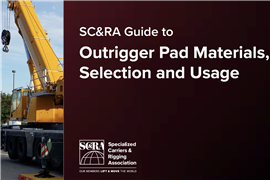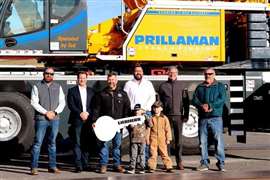Site Report: Pioneering purification in Oman
09 November 2010

Oman produces well over 0.7 million barrels of oil every day, and according to the BP Statistical Review of World Energy its proved reserves total some 5.6 billion barrels - about 0.4% of the world total. All of this oil is located under its rocky and inhospitable central and southern desert, and one of the problems with land-based oil extraction is that it requires a lot of water.
In order to displace the oil, water has to be injected into the wells. The oil and water are later separated of course, but it is impossible to remove all the hydrocarbons and other toxins from the water with physical systems. This means the pollutants can find their way back into groundwater and aquifers to contaminate them.
In a bid to address this, the state-owned oil producer Petroleum Development Oman (PDO) has commissioned foundations and ground works specialist Bauer to build what will be the world's largest reed bed water treatment plant on the oilfields near the town of Nmir.
Bauer Environmental has a patent on the process that makes use of the reed plants ability to absorb pollutants and therefore purify water.
After establishing up a small test bed to prove the concept, a special subsidiary Bauer Nmir was set up in 2009 to develop the full-scale plant. The US$ 174 million contract was awarded by PDO on a design, build, own, operate & transfer (DBOOT) basis, which will see the company operate the plant for a 20 year concession period before ownership is transferred to PDO.
450 football pitches
The scale of the scheme is enormous, with a total area of some 2.35 km2 - equivalent to 450 football pitches. The reed bed itself measures some 1.2 x 1.8 km and will be filled with 1.2 million plants, with most of the remainder of the site taken up by evaporation pans.
Surprisingly for a country as arid as Oman, the scheme does not feature any means of capturing the purified water, which Bauer said will be of good enough quality to be used directly in irrigation. Instead the only by-products are the reeds, which will be harvested for fuel, and the salts left behind by evaporation, which have industrial applications.
Once operational, the plant is designed to handle 45000 m3 of water per day - about 18% of the water used for extraction in the Nmir oilfield, in a process that requires about 8 litres of water for every 1 litre of crude oil produced.
From the oil fields, water will be pumped to a separator that will remove some of the oil. However, it will still contain between five and eight parts per million (PPM) of oil. To remove this it will be fed into the reed beds, which are arranged in four terraces 0.75 m above each other. Each terrace is sub-divided into six plots, so there are a total of 24 individual beds, each some 9 ha in area.
The OMR 11.3 million (US$ 29 million) contract for earthworks, including construction of the beds, evaporation pans and 24 km of dikes and roadways, was awarded by Bauer to one of Oman's largest general contractors, Sarooj Construction Company, which is a subsidiary of real estate and engineering conglomerate Al-Taher.
It is a demanding contract, requiring centimetre-accurate grading over passes of 300 m to ensure water flows properly across the beds - a task made harder by the harsh desert conditions and the presence of an unexpectedly large volume of rock near the surface.
Sarooj's project manager Marc Brijs took up the story. "In the original contract we expected 35000 m3 of rock. In fact we have almost 700000 m3 and that is a mini disaster. It is very hard material and we have to cut it all out," he said.
Originally Mr Brijs had hoped to rip the rock out with a dozer, but even D11-sized machine wouldn't shift it. Instead it is being painstakingly hammered out with hydraulic breakers mounted on a variety of 45 tonne class excavators.
One of the biggest equipment suppliers to the site is Caterpillar, and it has provided the machine controlled 14M and 14H graders that are being used for the fine levelling.
Once the reed beds have been excavated, they are lined with a layer of Laterite, a tropical clay similar to Bentonite, which is compacted to form an impermeable layer. The Laterite is produced on site from excavated materials. Indeed, one of the key reasons for the location of the plant was that this and other materials required for the scheme could be excavated and manufactured on site.
For the machine guidance system, Sarooj opted for the Sitevision system developed by Trimble on the 14H as well as Caterpillar's own Accugrade system on the 14M. Accugrade uses total stations and GPS to guide the machines and ensure an accurate grade is established. It is a more complex system than using lasers, according to Mr Brijs, a more suitable one for the site given its scale and the harsh, dusty environment.
However, the GPS system has not been without its problems. "GPS here is a tricky thing, because between 12.30 pm and 2.00 pm we only have five satellites visible. The rest of the time we have nine, and then the tolerances are fine, but there is kind of a hole."
Fortunately this 'hole' in the GPS signal coverage coincides with the lunch break - taken in the hottest part of the day when temperatures can exceed 45° C - so it hasn't caused too many problems. The working day runs from 6.00 am until noon, then there is a two-hour break, with the shift returning to work from 2.00 pm until 6.00 pm.
The contractor is experimenting with laying the Laterite layer and subsequent growing medium for the reeds with a paver. According to Mr Brijs, the 4 m wide Vögele paver can lay down about 8000 m3 of material per day which is already "nicely compacted" prior to being finished with a roller.
"It's a solution, but it's not THE solution," said Mr Brijs.
There are a total of 209 machines on site, about a quarter of which were supplied by Caterpillar and are owned by Sarooj. In fact when it comes to buying equipment, Sarooj only ever buys Caterpillar machines, although on this scheme it has also rented a range of equipment.
Besides the graders, compactors, excavators and breakers, the screening plant where the Laterite and other materials are produced is also populated by Cat excavators and loaders, alongside mobile screens from Powerscreen and McCloskey.
Most of the hauling and rough placing of the material is done using on-highway style tipper trucks. However, the excavated limestone is removed using four Cat articulated dump trucks (ADTs), whose tyres are more rugged, and better able to cope with the unforgiving, rocky terrain.
Final stages
Despite the set back of all the unexpected rock, Mr Brijs said all the reed beds should be completed and planted by the end of the year. Although the reeds appear to be planted sparsely in rows 10 m apart, within six months of being put in they will fill-out the beds and the plant can go into operation.
"When this solution is proven it will be used everywhere," said Mr Brijs. "It is large scale, but it is a low budget solution. You don't need power to run it - just a little for the pump - basically all you need is land."



